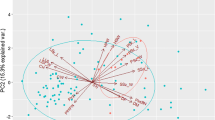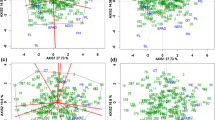Summary
Efficient utilization of divergent germ plasm sources in breeding cultivated Dactylis glomerata L. ssp. glomerata Domin depends on knowledge of quantitative variation within and among accessions. This study was undertaken to quantify variation and covariation for forage yield, maturity, disease reaction, and ground cover within a population of tetraploid Dactylis accessions. Variation was observed among families within the population for each variable. Most genetic variation (73%–93% of the family sums of squares) was within country sources or within accessions. Thus, country boundaries, which are traditionally important factors used in defining limits of plant exploration expeditions, have limited expected use in targeting future exploration for specific sources of high yield, disease resistance, or ground cover. Maturity was the exception to this; late-maturing accessions were identified as originating exclusively from the USSR. Some relationships among traits, such as that for yield and disease reaction, differed for accessions and cultivars. Several accessions and families within accessions were identified to have performance superior to most or all cultivars included in this study. Existing germ plasm from several countries was identified to have potential in breeding orchardgrass, while that from other countries appeared to have little or no potential in supplying germ plasm for hay production in humid-temperate environments.
Similar content being viewed by others
References
Bingham ET (1979) Maximizing heterozygosity in autopolyploids. In: Lewis WH (ed) Polyploidy: biological relevance. Plenum Press, New York, pp 471–489
Borrill M (1961) Dactylis marina Borrill, sp. nov., a natural group of related tetraploid forms. J Linn Soc London Bot 56: 431–439
Borrill M (1978) Evolution and genetic resources in cocksfoot. In: 1977 Annu Rep Welsh Plant Breed Stn, pp 190–209
Bravermann SW (1986) Disease resistance in cool season forage, range and turf grasses II. Bot Rev 52: 1–112
Broue P, Kawanabe S (1967) A relationship between seedling growth rates and latitude of origin of cocksfoot populations. Aust J Agric Res 18: 15–22
Burton GW (1979) Handling cross-pollinated germplasm efficiently. Crop Sci 19: 685–690
Busbice TH (1969) Inbreeding in synthetic varieties. Crop Sci 9: 601–604
Busbice TH, Gurgis RY (1976) Evaluating parents and predicting performance of synthetic alfalfa varieties. USDA-ARS Publ ARS-S-130, US Govt Print Off, Washington, DC
Carlson IT, Moll RH (1962) Phenotypic and genotypic variation and covariation in quantitative character in strains of orchardgrass. Crop Sci 2: 281–286
Casler MD (1988) Performance of orchardgrass, smooth bromegrass, and ryegrass in binary mixtures with alfalfa. Agron J 80: 509–514
Casler MD (1990) Cultivar and cultivar x environmental effects for relative feed value of temperature perennial grasses. Crop Sci 30: 722–728
Falcinelli M, Veronesi F, Lorenzetti S (1988) Evaluation of an Italian germplasm collection of Lolium perenne L. through a multivariate approach. In: Natural variation and breeding for adaptation, Proc Eucarpia Fodder Crops Section, 22–24 September 1987. INRA, Lusignan, France, pp 23–35
Gaylor DW, Lucas HL, Anderson RL (1970) Calculations of expected mean squares by the abbreviated Doolittle and square root method. Biometrics 26: 641–655
Gilmore EC (1969) Effect of inbreeding of parental lines on predicted yields of synthetics. Crop Sci 9: 102–104
Godshalk EB (1984) Genotype, environment, and genotype x environment interaction effects on orchardgrass seed and forage production. MSc thesis. The Pennsylvania State University, State College, Pa
Gouyon PH, Lumaret R, Valdeyron G, Vernet P (1983) Reproductive strategies and disturbance by man. In: Mooney H, Godron M (eds) Disturbance and ecosystems. Springer, Berlin Heidelberg New York, pp 214–225
Guignard G (1985) Dactylis glomerata spp. oceanica, taxon nouveau du littoral atlantique. Bull Soc Bot Fr 132: 341–346
Hanson AA (1972) Grass varieties in the United States. USDAARS Agric Handbook no 170, US Govt Print Off, Washington, DC
Hill RR Jr, Leath KT, Zeiders KE (1972) Combining ability among four-clone alfalfa synthetics. Crop Sci 12: 627–630
Jeyaratnam S, Graybill FA (1980) Confidence intervals on variance components in three-factor cross-classification models. Technometrics 22: 375–380
Kaiton RR, Smit AG, Leffel RC (1952) Parent-inbred progeny relationships of selected orchardgrass clones. Agron J 44: 481–486
Luedtke R (1984) Breeding orchardgrass for satisfactory Oregon seed yield combined with high Iowa forage yield and quality. PhD thesis, Iowa State Univ, Ames, Iowa (Diss Abstr no 8505841)
Lumaret R (1981) Structure génétique d'un complexe polyploide: Dactylis glomerata (Fam. Graminacées): relations entre le polymorphisme enzymatique et certains aspects de la biologie, de l'écologie et de l'évolution de l'espece. State doctoral thesis. Univ Sci Tech Languedoc, Montpellier, France
Lumaret R (1984) The role of polyploidy in the adaptive significance of polymorphism at the GOT-1 locus in the Dactylis glomerata complex. Heredity 52: 153–169
Lumaret R (1985) Phenotypic and genotypic variation within and between populations of the polyploid complex, Dactylis glomerata L. In: Haeck J, Woldendorp JW (eds) Proc 2nd Int Symp Structure and Functioning of Plant Populations. Elsevier/North Holland, Amsterdam, pp 343–354
Lumaret R (1988) Cytology, genetics, and evolution in the genus Dactylis. CRC Crit Rev Plant Sci 7: 55–91
Lumaret R, Guillerm JL, Delay J, Ait Lhaj Loufti A, Izco J, Jay M (1987) Polyploidy and habitat differentiation in Dactylis glomerata L. from Galicia (Spain). Oecologia 73: 436–446
Milliken GA, Johnson DE (1984) Analysis of messy data. Van Nostrand Reinhold, New York
Morrison DF (1976) Multivariate statistical methods. McGrawHill, New York
Müntzing A (1937) The effects of chromosomal variation in Dactylis. Hereditas 23: 113–235
Myers WM (1940) Tetrasomic inheritance in Dactylis glomerata. Genetics 25: 126
Myers WM (1941) Genetical consequences of chromosomal behavior in orchard grass, Dactylis glomerata L. J Am Soc Agron 33: 893–900
Pfeiffer TW, Bingham ET (1983) Improvement of fertility and herbage yield by selection within two-allele populations of tetraploid alfalfa. Crop Sci 23: 633–636
Rincker CM (1981) Long-term subfreezing storage of forage crop seeds. Crop Sci 21: 424–427
Roy J, Lumaret R (1987) Associated clinal variation in leaf tissue water relations and allozyme polymorphism in Dactylis glomerata L. populations. Evol Trends Plants 1: 9–19
Searle SR (1971) Linear models. John Wiley & Sons, New York
Snaydon RW (1987) Population responses to environmental disturbance. In: van Andel J, et al. (eds) Disturbance in grasslands. Causes, effects, and processes. Dr. W. Junk, Dordrecht, The Netherlands, pp 15–31
Speranza M, Cristofolini G (1986) The genus Dactylis L. in Italy. 1. The tetraploid entities. Webbia 39: 379–396
Stebbins GL, Zohary D (1959) Cytogenetic and evolutionary studies in the genus Dactylis. I: Morphology, distribution, and interrelationships of the diploid subspecies. Univ Calif [Berkeley] Publ Bot 31: 1–40
Steel RGD, Torrie JH (1980) Principles and procedures of statistics: a biometrical approach, 2nd edn. McGraw-Hill, New York
Tajimi A (1974) Tetrasomic inheritance of stem rust resistance in orchard grass. J Jpn Grassl Soc 20: 26–30
Tyler BF (1988) Description and distribution of natural variation in forage grasses. In: Natural variation and breeding for adaptation, Proc Eucarpia Fodder Crops Section, 22–24 September 1987. INRA, Lusignan, France, pp 13–22
USDA-ARS (1982) Plant inventory no. 187. Plant material introduced January 1 to December 31, 1979 (nos. 431464 to 436990). USDA-ARS, US Govt Print Off, Washington, DC
Van Soest PJ (1982) Nutritional ecology of the ruminant. O & B Books, Corvallis, Ore
Youngberg HW, Young WC III, Chilcote DO (1986) Oregon forage and turf grass variety seed yield trial 1984–85. Agr Exp Stn Spec Rep 766, Oregon State Univ, Corvallis, Ore
Author information
Authors and Affiliations
Additional information
Communicated by A. R. Hallauer
Rights and permissions
About this article
Cite this article
Casler, M.D. Genetic variation and covariation in a population of tetraploid Dactylis L. accessions. Theoret. Appl. Genetics 81, 253–264 (1991). https://doi.org/10.1007/BF00215731
Received:
Accepted:
Issue Date:
DOI: https://doi.org/10.1007/BF00215731




